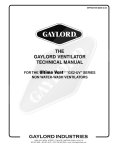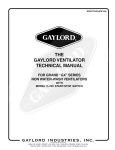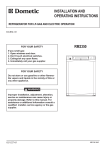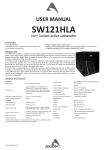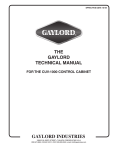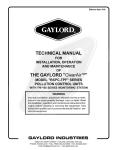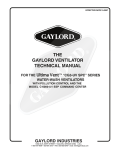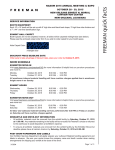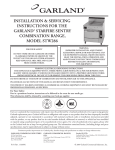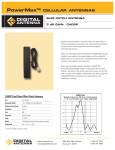Download gaylord industries
Transcript
EFFECTIVE DATE 4-05 THE GAYLORD VENTILATOR TECHNICAL MANUAL FOR THE GRAND “GX2” SERIES NON WATER-WASH VENTILATORS GAYLORD INDUSTRIES 10900 S.W. AVERY STREET • TUALATIN, OREGON 97062-1149 U.S.A. 800-547-9696 • 503-691-2010 • FAX: 503-692-6048 • email: [email protected] GAYLORD INDUSTRIES, INC. “Undisputed World Leader in Engineered Systems for Commercial Kitchens”tm World Headquarters: 10900 S.W. Averry Street • Tualatin, Oregon 97062-1149 U.S.A. To Our Customers. . . Congratulations on your recent purchase of a Gaylord kitchen exhaust hood system. We are proud to be able to provide you with a quality product that incorporates the latest engineering concepts and is a result of over 50 years of experience in the foodservice kitchen exhaust industry. If you have other Gaylord equipment such as a Gaylord Utility Distribution System, Quencher Fire Protection System, or Roof Top Air Handling Equipment, etc., please refer to the corresponding supplementary equipment manuals. If you have further questions, please call us toll free at 1-800-547-9696 or email:[email protected]. We are more than happy to help. Sincerely, Gaylord Industries STREET ADDRESS: 10900 S.W. Avery Street, Tualatin, Oregon 97062-8549 U.S.A. PHONE: 503-691-2010 • 800-547-9696 • FAX: 503-692-6048 • email: [email protected] • www.gaylordusa.com COMMERCIAL KITCHEN EXHAUST SYSTEMS • FIRE PROTECTION • UTILITY DISTRIBUTION • ROOF TOP UNITS • POLLUTION CONTROL TABLE OF CONTENTS “GX2” SERIES PRINCIPLE OF OPERATION ........................................................ 3 STANDARD MODELS ............................................................................................ 6 MAINTENANCE AND CLEANING INSTRUCTIONS.............................................. 7 TROUBLESHOOTING ........................................................................................... 8 MEASURING INLET SLOT VELOCITY ................................................................. 10 WIRING DIAGRAMS .............................................................................................. 13 PARTS LIST ........................................................................................................... 17 START-UP INSPECTION REPORT ....................................................................... 20 WARRANTY ................................................................................. Inside back cover PATENT NUMBERS U.S.A.: 4,266,529 4,281,635 4,356,870 CANADA: 1,139,151 1,155,366 GERMANY: 8,034,240 ALL RIGHTS RESERVED. NO PART OF THIS BOOK MAY BE REPRODUCED, STORED IN A RETRIEVAL SYSTEM, OR TRANSMITTED IN ANY FORM BY AN ELECTRIC, MECHANICAL, PHOTOCOPYING, RECORDING MEANS OR OTHERWISE WITHOUT PRIOR WRITTEN PERMISSION OF GAYLORD INDUSTRIES, INC. COPYRIGHT 2003. © Copyright 2005, Gaylord Industries The manufacturer reserves the right to modify the materials and specifications resulting from a continuing program of product improvement or the availability of new materials. ADDITIONAL COPIES $10.00 “GX2” SERIES PRINCIPLE OF OPERATION The Gaylord “GX2” Series Non Water-Wash Ventilator offers simplicity, economy and performance that no other ventilator can offer. The unique “extractor insert” gives a grease extraction efficiency far superior to that of a typical baffle filter. The Gaylord “GX2” Series Ventilators are UL Listed and meet all the requirements of NFPA #96 and the International Mechanical Code. through it. Grease extraction is accomplished by unique, removable stainless steel “extractor inserts” which incorporates a series of horizontal baffles. As the air moves through the extractor at high speed, it is forced to make a series of turns around these baffles, forcing the heavierthan-air particles of grease, dust, and lint to be thrown out of the airstream by centrifugal force. The sticky grease collects in the extractor and the liquified grease drains down into the main grease gutter which slopes to the grease cup. Note: Some ventilators may be equipped with optional “Custom Air” baffles (shown dotted) to reduce the exhaust volume over specific light duty cooking appliances. The extractor inserts come in two sizes15½" (5.6 lbs.) and 19½" (6.75 lbs.). IMPORTANT NOTE: Never operate ventilator without extractor inserts in place. EXHAUST FAN OPERATION The exhaust fan is controlled by the Gaylord C-150 “Exhaust Fan Start/Stop Switch”, an optional switch, or a standard wall switch. The switch is usually located on a wall near the ventilator. When the switch is flipped up to the on position, the damper begins opening to the exhaust position (refer to Fig. 1). After the damper opens (approximately 80 seconds) the exhaust fan will come on. GREASE EXTRACTION The Gaylord “GX2” Series Ventilator extracts 90% of the grease, dust, and lint particles from the airstream passing FIG. 1 3 “GX2” SERIES PRINCIPLE OF OPERATION CLEANING At the end of the cooking day the exhaust fan is turned off by the “Exhaust Fan Start/ Stop Switch.” In addition to the fan going off, the two position damper moves to the fan off position (See Fig 2.). This prevents conditioned air from going up the exhaust system during off hours. After the fan has been turned off, the extractor inserts are removed and can be washed either in a dishwasher or soaked and rinsed off. The grease cup is also removed and emptied at this time. To ease in the removal of the extractor inserts, an “Extractor Removal Tool” is available which eliminates the need for kitchen personnel to climb up on the cooking equipment, or up a ladder. FIG. 2 4 “GX2” SERIES PRINCIPLE OF OPERATION FIRE PROTECTION the ductwork and spreading to other parts of the building. The fire is contained in the kitchen area where it can be properly fought. After the thermostat cools below 250°F, the damper automatically opens to the exhaust position and the fan re-starts. NFPA #96 requires the use of surface, duct and plenum protection on all hoods. It is these systems that are the first line of defense against equipment fires. The “GX2” Series ventilator incorporates a two position damper, a fail safe damper control and a fail safe thermostat. In the event of a fire, should the thermostat located at the duct collar reach 250°F, the damper control is de-energized closing the damper to the fire position (See Fig. 3) and the exhaust fan shuts off. This prevents the flames from entering Surface, duct collar and plenum fire protection utilizing The Gaylord Quencher System or other fire protection systems currently on the market can be factory installed as an option. FIG. 3 5 STANDARD VENTILATOR MODELS Model GX2-BDL Model GX2-BDL-CL Application - Wall mounted canopy style for all types of equipment. Application - For single island arrangements Model GX2-BDL-DS Model GX2-BDL-BB Application - For island style cooking arrangements where one side of the cooking line is light duty equipment and the other side medium duty equipment. Application - For island style cooking arrangements over all duties of equipment. STANDARD MAKE-UP AIR OPTIONS The make-up air options shown below are available on all BDL Series Ventilators except the MAI Series is not available on the GX2-BDL-CL. MODEL “MAW” SERIES MODEL “MAI” SERIES FRONT FACE DISCHARGE INTERNAL DISCHARGE This method of introducing make-up air into the kitchen is flexible and has many advantages. Make-up air is discharged through stainless steel perforated panels as illustrated (MAW Series) or optional registers (MAR Series). Typical supply volume is 80% of the exhaust or more, depending on air balance desired. Supply air temperatures should range from 60 to 65°F (16 to 18°C), but may be as low as 50°F (10°C) depending on air volume, distribution, and internal heat load. This method of introducing air into the hood is typically referred to as the “short circuit” method. This design has very limited applications and the amount of supply air able to be introduced varies considerably with the type of cooking equipment. This air may be untempered air in most areas depending upon climatic conditions and the type of cooking equipment. The difference between the quantity of air being introduced and the amount of air being exhausted must be supplied through a traditional make-up air system. 6 MAINTENANCE AND CLEANING INSTRUCTIONS CLEANING At the end of each cooking day, the exposed interior surfaces of the ventilator should be wiped down and the grease cup emptied. During the course of operation, grease particles are gradually collecting inside the extractor inserts. Daily, or at periodic intervals, depending on the type of cooking, the extractor inserts must be removed and cleaned. To clean, proceed as follows: 1.Remove extractor inserts by hand or by using the extractor removal tool. CAUTION: Care should be taken when removing extractors, especially over fryers. It is recommended that the cooking equipment be cooled down and the fryers be covered prior to removing extractors. To remove, lift up slightly on extractor insert and pull straight out. 2.Extractor inserts may be cleaned either by using a dishwasher or by washing in a sink using hot water and a degreasing detergent. Formula G-510 is highly recommended for this application. For information contact: 20/10 Products Inc. P.O. Box 7609 Salem, OR 97303 Phone: 800-286-2010 Fax: 503-363-4296 E-mail: [email protected] 3.With the extractor inserts removed, wipe and clean the back wall and the grease gutter with hot detergent water. NOTE: If a steam or hot water pressure washer is used for periodic cleaning of the interior, connect a hose to the gutter drain and lead it to a floor sink or large bucket to drain off the water. 4.To replace the extractor inserts, care must be taken to insure that point “A” rests in the rear clip as illustrated in Fig. 4. 5.If the ventilator(s) has a fuse link operated supply duct fire damper NFPA-96 requires inspection of the fuse link every 6 months and replacement annually. INSPECTION AND CLEANING REQUIREMENTS The 2001 edition of NFPA-96 (Standard for Ventilation Control and Fire Protection of Commercial Cooking Operations) require that hoods, ducts and exhaust fans be inspected by a properly trained, qualified and certified company or person(s) in accordance with the following table. Upon inspection, if found to be contaminated with deposits from grease- laden vapors, the entire exhaust system shall be cleaned by a properly trained, qualified, and certified company or person(s) acceptable to the authority having jurisdiction. When a vent cleaning service is used, a certificate showing date of inspection or cleaning shall be maintained on the premises. After cleaning is completed, the vent cleaning contractor shall place or display within the kitchen area a label indicating the date cleaned and the name of the servicing company. It shall also indicate areas not cleaned. Factory trained service agencies are certified by Gaylord Industries, Inc. to perform these inspections. For the name and phone number of your nearest agent call 800-547-9696 or www.gaylordusa.com and go to service. EXHAUST SYSTEM INSPECTION SCHEDULE Systems serving solid fuel cooking operations Monthly Systems serving high-volume cooking operations such as 24-hour cooking, charbroiling or wok cooking Quarterly Systems serving moderate-volume cooking operations Semiannually Systems serving low-volume cooking operations, such as churches, day camps, seasonal businesses, or senior centers Annually CAUTION: Care should be taken when removing extractors, especially over fryers. It is recommended that the cooking equipment be cooled down and the fryers be covered prior to removing extractors. FIG. 4 7 TROUBLE-SHOOTING SYMPTOM SMOKE LOSS 1. Smoke Loss- Ventilator is not exhausting properly. POSSIBLE PROBLEM CORRECTIVE ACTION A. L o w a i r v e l o c i t y - Av e r a g e a i r v e l o c i t y through the air entr y slot should be in accordance with the Air Velocity Char t on page 10. For proper method of measuring t h e a i r ve l o c i t y, r e fe r t o p a g e 1 1 . I f t h e velocity is low check the following. 1. Broken or slipping belt on the exhaust fan. 2. Proper rotation of the exhaust fan wheel. 3. P r o p e r s i z e o f e x h a u s t f a n ( f a n m u s t deliver nameplate rating). 4. Ductwork inspection panel left open. 5. Damper not open or in proper position. B. The Gaylord Ventilator must have its own ex h a u s t s y s t e m a n d n o o t h e r ex h a u s t , such as dishwasher hoods, should be tied into it. 1. Inspect duct system and verify that there are no type II ventilator systems tied in. If so they must be removed. C. Improperly placed make-up air diffusers. 1. Make-up air directed at the ventilator will likely create cross drafts disrupting the air flow into the ventilator. Adjust the louvers to direct the make-up air away from the ventilator. 2. Make-up air should be delivered through full length perforated diffusers or registers at ceiling height distributed throughout the kitchen area. 3. M a k e - u p a i r r e g i s t e r s l o c a t e d n e a r t h e ventilator, the louvers should be adjusted to direct the air away from the ventilator. D i r e c t i n g o r fo r c i n g m a k e - u p a i r a t t h e ve n t i l a t o r t y p i c a l l y c r e a t e s c r o s s d r a f t s resulting in smoke loss. D. Inadequate make-up air. 1. M a k e - u p a i r m u s t b e s u p p l i e d f o r replacement of air exhausted through all kitchen exhaust systems. 2. A general "rule of thumb" is that 75% to 80% of the replacement air should be fresh, conditioned, (heated or cooled) air brought into the kitchen area, with the remaining 20% to 25% allowed to flow into the kitchen from adjacent areas. E. Exhaust fan discharge. 1. T h e r e s h o u l d b e n o s c r e e n o v e r t h e d i s c h a r g e . I f o n e i s fo u n d , i t s h o u l d b e removed. 2. The direction of discharge should not be into the prevailing winds nor downward onto the roof. A ver tical discharge is highly recommended. GREASE EXTRACTION 1. Poor Grease Extraction. A. T h e G a y l o r d " G X 2 " S e r i e s Ve n t i l a t o r extracts up to 90% of the grease, dust and lint par ticles from the airstream passing through it, when operated and maintained in accordance with design specifications. I f i t a p p e a r s t h a t t h e ve n t i l a t o r i s n o t extracting properly, typically the exhaust volume is low. 8 1. Check the inlet slot velocity as described on pages 10 through 12. If the velocity is not within the required range, increase or reduce the fan speed as required. TROUBLE-SHOOTING SYMPTOM EXHAUST FAN POSSIBLE PROBLEM CORRECTIVE ACTION 1. The fan switch is turned on but damper does not move to the open position and exhaust fan does not star t but you can hear the fan running. A. Fan on/off switch has not been wired through the ventilator. 1. R e f e r t o w i r i n g d i a g r a m i n t h i s manual and re-wire. 2. If when the fan switch is turned on the damper moves to the exhaust postion but the exhaust fan does not come on. A. Overload protector on magnetic star ter tripped. 1. P u s h t h e " R e s e t " b u t t o n o n t h e magnetic star ter and the push the "Star t Fan" button on the command center. B. If an HOA (Hands On/Automatic) type m a g n e t i c s t a r t e r sw i t c h i s u s e d , t h e selector switch may have been moved from the automatic position 1. Check switch and turn selector to the automatic position. C. Exhaust fan circuit breaker tripped. 1. Re-set circuit breaker D. I f t h e s y s t e m i s e q u i p p e d w i t h a n disconnect switch for the exhaust fan, a fuse or fuses may have blown out. 1. C h e c k c o n t i n u i t y o f f u s e s a n d replace if necessar y. E. Fan on/off switch has not been wired properly through the ventilator. 1. R e f e r t o w i r i n g d i a g r a m i n t h i s manual and re-wire. 9 MEASURING INLET SLOT VELOCITY MEASURING INLET SLOT VELOCITY Smoke capture and grease extraction efficiency are dependent upon the proper air velocity at the inlet slot of the ventilator.The required average slot velocities are shown on the “Air Velocity Chart” below. If the slot velocity is below the required average, the exhaust fan must be adjusted accordingly. NOTE: The height of the inlet slot can vary depending upon the design of the ventilator. It is, therefore, important to first measure the inlet slot and compare it to the chart below to determine the required average inlet slot velocity. The designed CFM per lineal foot is related to the velocity as shown on the chart below. The total CFM for the ventilator can be found on the ventilator nameplate. (See Figure 6). AIR VELOCITY CHART FOR ALL "GX2" SERIES EXCEPT "DS" SERIES Without Custom Air Baffles Nominal Height Designed of Inlet Slot CFM per Lineal Ft. With Custom Air Baffles Average Inlet Slot Velocity (FPM) Designed CFM per Lineal Ft. Min. Optimum Max. 3" 4" Average Inlet Slot Velocity (FPM) Min. Optimum Max. 250 1300 1380 1450 150 760 800 880 270 1360 1435 1500 160 790 830 870 285 1425 1500 1575 170 810 855 900 300 1465 1545 1625 180 845 880 935 400 1690 1780 1870 250 1040 1095 1150 FOR "DS" SERIES VENTILATORS* Designed CFM Per Lineal Ft. Required Average Inlet Slot Velocity (FPM) Total Both Slots Front Slot Rear Slot 300 150 150 760 800 880 595 625 655 400 250 150 1375 1450 1520 595 625 655 Front Slot Rear Slot Min. Optimum Max. Min. Optimum Max. Air velocity readings less than what is specified on the “Air Velocity Chart” may allow smoke and grease to escape the confines of the ventilator and/or reduce grease extraction efficiency. This can result in grease deposits which lead to sanitation problems or fire hazards if left uncorrected. If air velocity readings are higher than those specified, it will require more energy to operate the exhaust fan and excessive noise levels will result. Higher or lower velocities than the required average will normally put the entire heating and ventilating system out of balance. When measuring the air velocity it is very important to take an average reading across the inlet slot plane as described on Page 11. Positioning the sensing head incorrectly will give velocity readings that cannot be compared to the “Air Velocity Chart”. 10 MEASURING INLET SLOT VELOCITY The standard instrument used for measuring the inlet velocities on a Gaylord Ventilator is a Pacer, Model DA40 or DA4000 Digital Anemometer. This instrument is the easiest, most accurate and the best suited for measuring ventilator inlet slot velocities. To take accurate air velocity readings, follow the instructions below. Instructions FIG. 5A FIG. 5B 1. It is first necessary to determine if the ventilator includes Custom Air baffles as shown in Fig. 5B. If shop drawings are available, and if equipped, the custom baffles and their location will be noted on the front elevation. If not available, to determine if Custom Air baffles are provided run your hand along the bottom inlet slot and feel for the Custom Air baffle as illustrated in Fig. 5B. 2. If the ventilator includes Custom Air baffles, it will be necessary to take two sets of readings - one for the section of ventilator that includes Custom Air baffles and one where it does not. 3. Attached the sensing head guide bracket, Gaylord Part Number 18408, to the sensing head. 4. Attach the cable from the sensing head to the meter and the handle sections to the sensing head. 5. Place the sensing head guide bracket against the lower lip of the inlet slot as illustrated. 6. Using the 16 second averaging feature on the meter, slide the sensing head along the slot, back and forth, for a 3'-0" to 4'-0" distance, and record the velocity at the end of the 16 second mark. Continue this process for the full length of the ventilator. Important Note: If the ventilator includes custom air baffles as illustrated in Fig. 5B, always take separate readings on the section of the ventilator that includes custom air from the section that does not have the baffles. Non custom air and custom air readings must be recorded separately. Do not average them together. Important Note: On the rear slot of a Model BDL-DS Series, do not use the guide bracket. Refer to Figure 5C. 7. Record the velocity (fpm) on the start up inspection report form. A sample report form, which can be photocopied, is provided on page 16. 8. The designed, or optimum velocity, is noted on the shop drawings and the Air Velocity Chart on page 10. Two velocities will be noted if the ventilator includes custom air baffles. 9. Compare the recorded air velocity to the designed air velocity shown on the shop drawings or the Air Velocity Chart on page 10. The recorded velocity may be slightly lower or higher providing that it is within the minimum and maximum range as shown on the Air Velocity Chart . If the air velocity is outside the minimum/maximum range, the performance of the ventilator will be affected and therefore the exhaust fan must be adjusted. FIG. 5C CROSS SECTION OF TYPICAL VENTILATOR INLET SLOTS 11 MEASURING INLET SLOT VELOCITY ENGINEERING DATA LISTED 370Y EXHAUST HOOD WITH EXHAUST DAMPER THIS EXHAUST HOOD HAS BEEN TESTED TO STANDARD UL 710 "EXHAUST HOODS FOR COMMERCIAL COOKING EQUIPMENT" THIS EXHAUST HOOD IS LISTED UNDER UL FILE NUMBER MH11403 THIS EXHAUST HOOD MEETS ALL REQUIREMENTS OF THE LATEST EDITION OF NFPA96 AND THE IMC (INTERNATIONAL MECHANICAL CODE) o 1. MINIMUM TOTAL EXHAUST VOLUME FOR THIS HOOD SECTION C.F.M. 2. MAXIMUM TOTAL SUPPLY VOLUME FOR THIS HOOD SECTION C.F.M. 3. EXHAUST STATIC PRESSURE AT DUCT COLLAR W.G. 4. SUPPLY STATIC PRESSURE AT DUCT COLLAR W.G. °F FOR LINEAL FT. OF HOOD °F FOR LINEAL FT. OF HOOD 6. REFER TO GAYLORD VENTILATOR TECHNICAL MANUAL FOR INLET VELOCITY REQUIREMENTS AND METHOD OF CHECKING VELOCITY 8. ON "GX2" and "PG" SERIES VENTILATORS EQUIPPED WITH FUSE LINK OPERATED EXHAUST FIRE DAMPER USE ONLY 280° F , RATED 30 LBS. MIN. UL LISTED FUSIBLE LINK FOR REPLACEMENT 9. IF HOOD IS EQUIPPED WITH INTEGRAL MAKE-UP AIR WITH FUSE LINK OPERATED FIRE DAMPER USE ONLY 165° F, RATED 30 LBS. MIN. UL LISTED FUSIBLE LINKS FOR REPLACEMENT 10.DUCTWORK AND EXHAUST FAN A. STATIC PRESSURE OF DUCT SYSTEM MUST BE ADDED TO VENTILATOR STATIC FOR TOTAL SYSTEM STATIC B. ALL DUCTWORK MUST BE WELDED LIQUIDTIGHT MINIMUM DISTANCE FROM COOKING SURFACE TO FRONT LOWER EDGE OF HOOD MAXIMUM DISTANCE FROM COOKING SURFACE TO FRONT LOWER EDGE OF HOOD MINIMUM OVERHANG FROM FRONT OF HOOD CAVITY TO FRONT OF COOKING SURFACE MINIMUM OVERHANG FROM SIDE OF HOOD TO EDGE OF COOKING SURFACE WORLD HEADQUARTERS GAYLORD INDUSTRIES, INC. 10900 S.W. AVERY STREET TUALATIN, OR 97062-8549 USA PHONE: 1-503-691-2010 FAX: 1-503-692-6048 EMAIL: [email protected] UL-GX2/PG 1000 FIGURE 6 7. ELECTRICAL RATING OF LIGHT FIXTURES: 120 VOLT, 60 HZ. OR 220 VOLT, 50 HZ. OVERALL RATING - 12 AMPS OR LESS MAXIMUM SETBACK FROM FRONT OF HOOD CAVITY TO FRONT OF COOKING SURFACE PATENT PENDING TOTAL SUPPLY CFM HERE 5. THIS HOOD SECTION SUITABLE FOR APPLIANCES WITH MAXIMUM COOKING SURFACE TEMPERATURE OF: HOOD MOUNTING REQUIREMENTS SUPPLIED WITH FACTORY INSTALLED UL LISTED GRINNELL CORP. EA-1, 1/4" ORIFICE, 65 DEGREE DEFLECTOR SPRINKLER(S) FOR THE PROTECTION OF UNLIMITED LENGTH OF GREASE DUCT HAVING A MAXIMUM DUCT PERIMETER OF 50 INCHES PER SPRINKLER. CONNECT TO NFPA 13 SPRINKLER SYSTEM WATER SUPPLY ONLY. TOTAL EXHAUST CFM HERE SERIAL NO: MODEL NO: MAINTENANCE INSTRUCTIONS 1. REMOVE, INSPECT AND CLEAN FILTERS OR GAYLORD EXTRACTOR CARTRIDGES AS REQUIRED 2. REMOVE AND EMPTY GREASE CUP AS REQUIRED 3. CAUTION - DO NOT OPERATE VENTILATOR WITHOUT FILTERS OR EXTRACTOR CARTRIDGES IN PLACE 4. REPLACE FILTERS IN "PG" SERIES ONLY WITH UL CLASSIFIED GREASE FILTERS. IN "PGX" AND "GX2" SERIES REPLACE WITH GAYLORD INDUSTRIES EXTRACTOR CARTRIDGES. 5. IF THE VENTILATOR(S) HAS A FUSE LINK OPERATED EXHAUST OR SUPPLY DUCT FIRE DAMPER THE NATIONAL FIRE PROTECTION ASSOCIATION'S PAMPHLET NFPA-96 REQUIRES INSPECTION OF THE FUSE LINK EVERY 6 MONTHS AND REPLACED ANNUALLY. REFER TO THE GAYLORD VENTILATOR TECHNICAL MANUAL FOR DETAILS. 12 The total required exhaust volume can be found stamped on the UL nameplate located on each hood section. WIRING DIAGRAM 13 WIRING DIAGRAM GX2 Wiring With Electric Damper (Multi-Section First or Intermediate) 14 WIRING DIAGRAM GX2 Wiring With Electric Damper (Single Section or Last Section) 15 WIRING DIAGRAM 16 PARTS LIST GAYLORD PART NO. DESCRIPTION ILLUSTRATION 18380 18385 15-1/2" Extractor Inser t 19-1/2" Extractor Inser t (250 CFM/Lin. Ft. Extractors) 18745 18746 15-1/2" Extractor Inser t 19-1/2" Extractor Inser t (400 CFM/Lin. Ft. Extractors) 10321 165°F Fuse Link for Supply Ducts 18806 18466 Exhaust Duct Thermostat (N.C.) 6" Length 250°F. (For 250 Extractor) 15" Length 250°F. (For 400 Extractror) 18400 Extractor Removal Tool (For 250+ 400 CFM/Lin.Ft. Extractors) 10119 Light Globe - Clear 13211 Incandescent Light Lens & Frame 12" x 12" Recessed Light Lens & Retainer 13210 10111 10112 Fluorescent Light Lens & Frame 2 Ft. Recessed Light Lens & Retainer 3 Ft. Recessed Light Lens & Retainer 4 Ft. Recessed Light Lens & Retainer 13075 Grease Cup 3-1/4" x 6" x 4" 18314 C-150 Star t/Stop Switch Control 17 DAMPER CONTROL MODEL C-99 SERIES PC. NO. 1. DESCRIPTION Damper Control With Linkage (120 Volt) ---------------------------------- 18 GAYLORD PART NO. 18451 VENTILATOR START-UP INSPECTION REPORT For Model “GX2” Series Ventilators Job Name ______________________________________________________________________________ Gaylord Representative ____________________________________________________________ Address ________________________________________________________________________________ Representative Company Name ______________________________________________________ ______________________________________________________________________________________ City/State Zip File Number _______________________________________________ Date _________________ Facility Contact Name _________________________________________ Phone # ____________________ CSA Contacted __________________________________________________________________ MAKE-UP AIR 3. If the “GX2” Series ventilator(s) is interconnected with any “CG3” water wash series, perform the following test: A. With the exhaust fan on, open the electrical compartment on the control cabinet and push the “FIRE TEST” button. The following should occur: 1. Exhaust fan shut off ___Yes ___No 2. Damper fully closed ___Yes ___No B. At conclusion of the test push the “CANCEL” button. The following should occur: 1. The damper stayed closed ___Yes ___No 2. Fan stayed off ___Yes ___No C. Push the “START FAN” button. The following should occur: 1. Damper moves to the fully open position ___Yes ___No 1. Kitchen make-up air supply is turned on______Yes______No 2. Type of make-up air ¨ Ceiling Registers ¨ Built into Hood ¨ Ceiling Linear Diffusers ¨ Other 3. If ceiling register or linear diffusers approximate distance from face of hood _____________________________________________________________ FIRE DAMPER INFORMATION ¨ Ventilator has electric fire damper (GX2 Series) ¨ Ventilator has fuse link fire damper (GX2-FLD Series) ¨ Ventilator does not have a fire damper (GX2-ND Series) 2. Exhaust fan comes on ___Yes ___No AIR VOLUME READINGS Push “Start Fan” and take velocities. Record as follows: Exhaust record in the “EX” row, Exhaust at Custom Air baffles (if applicable) record in the “CA” row, and Make-up Air record in the “MA” row. ITEM NO. AIR VELOCITIES (FPM) FROM LEFT TO RIGHT HOOD SLOT OR MAKE-UP AIR DISCHARGE HOOD SERIAL NO. AVERAGE INSTALLATION INCLUDES THE FOLLOWING: ¨ Gaylord Rooftop Unit (GRT) ¨ Gaylord Clearair Pollution Control Unit (RSPC) ¨ The Gaylord “Quencher” Fire Protection System ¨ Gaylord Distributor (UDS) ¨ Wet Chemical Fire Protection System EX CA Personnel provided with ventilator technical manual________Yes________No MA Inspection Witnessed By (Print Name) ______________________________________________________ Signature ________________________________________________ Date _______________________ EX CA MA Comments ____________________________________________________________________________ ____________________________________________________________________________________ ____________________________________________________________________________________ EX ____________________________________________________________________________________ CA MA ELECTRIC DAMPER TEST (If equipped): 1. Remove one or more extractors so damper is visible. Push the “START FAN” button. A. The damper should move to the fully opened position in approx. 1 minute 15 seconds. _____Yes ___No B. The exhaust fan came on ___Yes ___No 2. Push “STOP FAN” button. A. The damper should move to the fully closed position in approx. 15 seconds_____Yes_____No B. The exhaust fan shut off ___Yes ___No Form No. GX2SUR200 ____________________________________________________________________________________ __________________________________________________________________________________________________ __________________________________________________________________________________________________ Distribution: WHITE-Gaylord Industries, Inc. YELLOW-Customer PINK-Dealer GOLDENROD-Sales Rep Litho U.S.A. GAYLORD INDUSTRIES 10900 S.W. Avery Street • Tualatin, OR 97062-1149 PHONE:1-503-691-2010 • FAX: 1-503-692-6048 • email:[email protected] LIMITED WARRANTY THE GAYLORD NON WATER-WASH VENTILATOR LIMITED WARRANTY August 2000 The Gaylord Ventilator and component parts furnished with The Gaylord Ventilator by the Licensed Gaylord Manufacturer are warrantied by the Licensed Gaylord Manufacturer producing the ventilator to be free from defects of material and workmanship under normal use when installed, operated and serviced in accordance with factory recommendations. The Licensed Gaylord Manufacturer's obligation under this warranty and any warranties implied by law shall be limited to repairing or replacing at its option any part of said equipment when the Licensed Gaylord Manufacturer's examination shall disclose to its satisfaction to be thus defective, for a period of one (1) year from the date of beneficial use, or eighteen months from date of shipment, whichever occurs first, provided proper and acceptable evidence of such is recorded at the factory. THE LICENSED GAYLORD MANUFACTURER SHALL NOT BE RESPONSIBLE FOR INCIDENTAL OR CONSEQUENTIAL DAMAGES RESULTING FROM A BREACH OF THIS WARRANTY. In the United States the labor required to make repairs and replacements under this warranty shall be furnished by Gaylord Industries Inc. or the Licensed Gaylord Manufacturer or its authorized representative. Such labor shall only be provided Mondays through Fridays between the hours of 8 a.m. and 4 p.m. Requests for repairs or replacement parts should be made to GAYLORD INDUSTRIES INC., P.O. Box 1149, Tualatin, Oregon 97062-1149. Outside the United States, all replacement parts furnished under this warranty shall be F.O.B. Gaylord Industries, Inc., Tualatin, Oregon U.S.A. The owner shall pay the necessary freight delivery charges, and the necessary labor for removal and installation of parts, and any tariffs, duties or taxes. This warranty does not cover routine maintenance or malfunctions or improper operation caused by fluctuating electrical power or power surges, and improper exhaust fan operation. This is the sole warranty with respect to the aforesaid items. NEITHER THE GAYLORD LICENSEE NOR ANY OTHER PARTY MAKES ANY OTHER WARRANTY OF ANY KIND WHATSOEVER, EXPRESSED OR IMPLIED, AND ALL IMPLIED WARRANTIES OF MERCHANTABILITY AND FITNESS FOR A PARTICULAR PURPOSE WHICH EXCEED THE AFORESAID OBLIGATIONS ARE HEREBY DISCLAIMED AND EXCLUDED FROM THIS AGREEMENT. WORLDWIDE SALES, MANUFACTURING AND SERVICE FOR THE NAME AND LOCATION OF THE NEAREST CERTIFIED SERVICE AGENCY, VISIT OUR WEB SITE: WWW.GAYLORDUSA.COM OR CONTACT US AT: GAYLORD INDUSTRIES 10900 S.W. AVERY STREET TUALATIN, OREGON 97062-1149 U.S.A Phone: 503-691-2010 1-800-547-9696 Fax: 503-692-6048 email: [email protected] LOCAL SERVICE AGENCY FORM NO. TM-GX2 203 / 30401 © COPYRIGHT 2005, GAYLORD INDUSTRIES LITHO IN U.S.A.
























